| Srl | Item |
| 1 |
ID:
155507
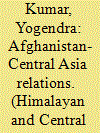

|
|
|
| 2 |
ID:
141512
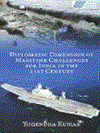

|
|
|
|
|
| Publication |
New Delhi, Pentagon Press, 2015.
|
| Description |
xii, 258p.hbk
|
| Standard Number |
9788182748538
|
|
|
|
|
|
|
|
|
|
|
|
Copies: C:1/I:0,R:0,Q:0
Circulation
| Accession# | Call# | Current Location | Status | Policy | Location |
| 058347 | 359.03054/KUM 058347 | Main | On Shelf | General | |
|
|
|
|
| 3 |
ID:
117536
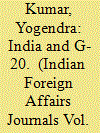

|
|
|
| 4 |
ID:
158607
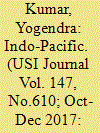

|
|
|
| 5 |
ID:
162082
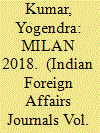

|
|
|
| 6 |
ID:
154589


|
|
|
|
|
| Summary/Abstract |
The expression ‘Indo-Pacific’ is currently being used in three different ways
by the Americans. ‘Indo-Pacific’ is essentially used to mean the eastern Indian
Ocean as well as the Pacific Ocean which is the US Pacific Command’s
(PACOM) area of operation. The ‘Asia-Pacific’, on the other hand, is taken
to mean South-east Asia and East Asia along with the Pacific Ocean which is
also, broadly speaking, the PACOM’s area of responsibility even as it includes
continental landmass and populations which remain an important focus of US
policy of creating a security system in this vast area. ‘Indo-Asia-Pacific’, yet
another phrase, is a mix of the above two expressions which includes the
oceanic waters as well as the East Asian landmass. The use of ‘Indo’ in these
expressions also reflects the US desire to involve India in the maintenance of
the strategic stability in the area mentioned
|
|
|
|
|
|
|
|
|
|
|
|
|
|
|
|
| 7 |
ID:
137120
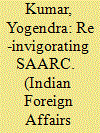

|
|
|
|
|
| Summary/Abstract |
It is now universally recognised that the regional cooperation in South Asia is far less developed in comparison to other regions. There is irony in this situation, as countries in the region have very strong historical and civilisational links even as they occupy the same economic space. These regional commonalities were sought to be fleshed out through the establishment of the South Asian Association for Regional Cooperation (SAARC) in December 1985. It was expected that these commonalities would provide a strong enough basis for significant regional integrationas, indeed, it was before 1947and for socio-economic progress, thereby strengthening regional political stability by keeping the negative tendencieslike backwardness, obscurantism and extremismat bay.
Yet, the sad reality is that other regional organisations, such as the European Union and the ASEANcomprising an even more diverse group of countrieshave been far more successful than SAARC. Indeed, the latter could, perhaps, be less favourably compared even with more recent organisations such as the African Union or the ECO. As an organisation, SAARC has underperformed throughout its history, and the level of regional integration is woefully short of its promise. Even its summits are becoming irregular. Perhaps, the unsatisfactory level of regional integration can partly be considered as a contributory factor in the prevailing situation where the region represents a microcosm of the range of security threats being faced by the world at large. This reality appears even more distressing, given the considerable ongoing movement of peoples in South Asia across borders, and the phenomenon of very easy social relationships overseas amongst members of the respective Diasaporas..
|
|
|
|
|
|
|
|
|
|
|
|
|
|
|
|